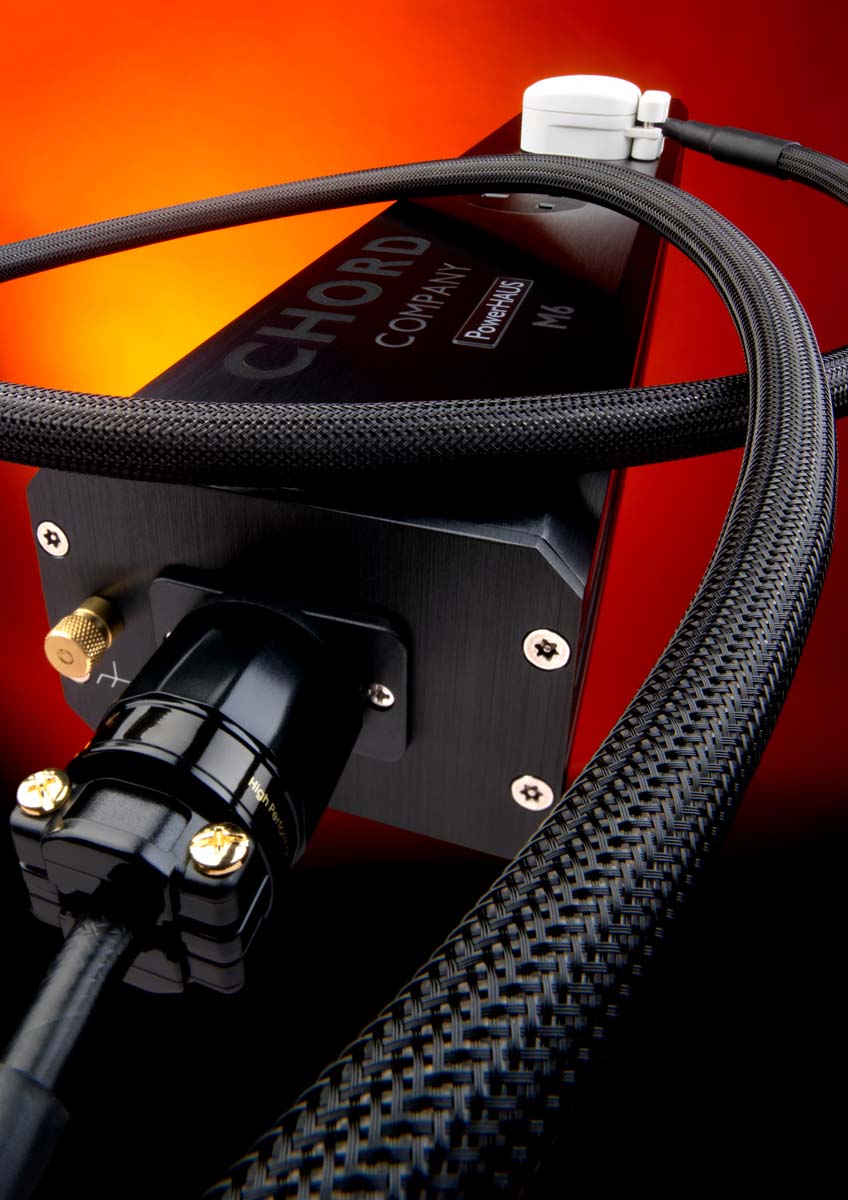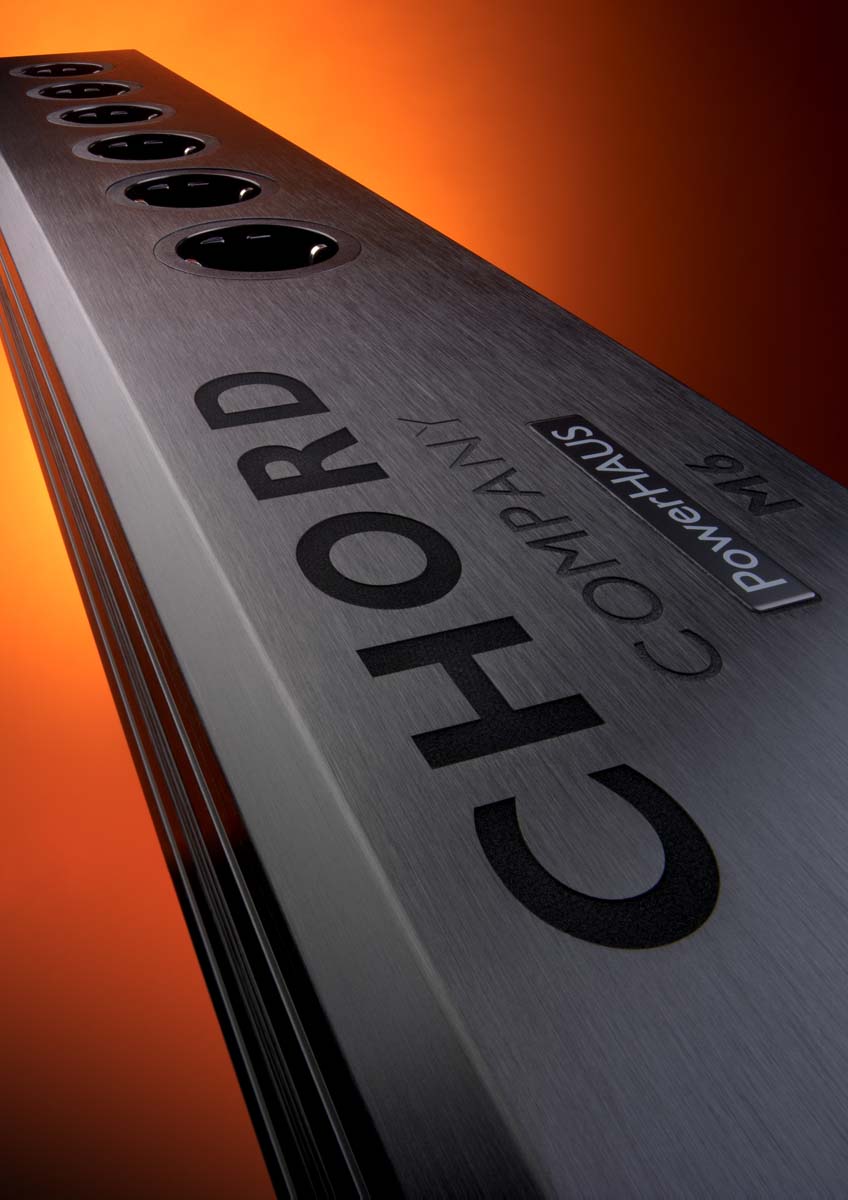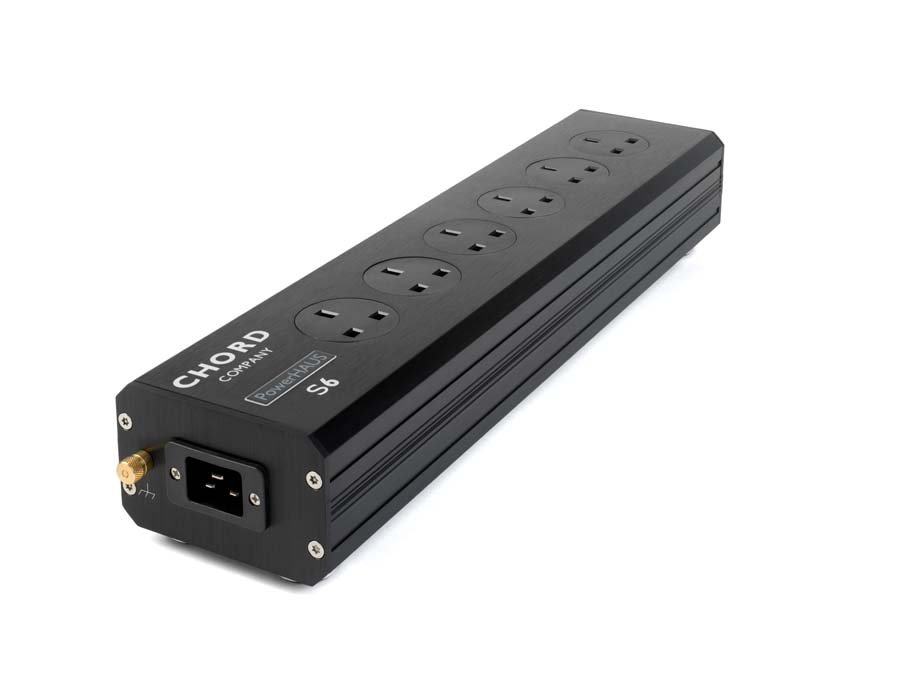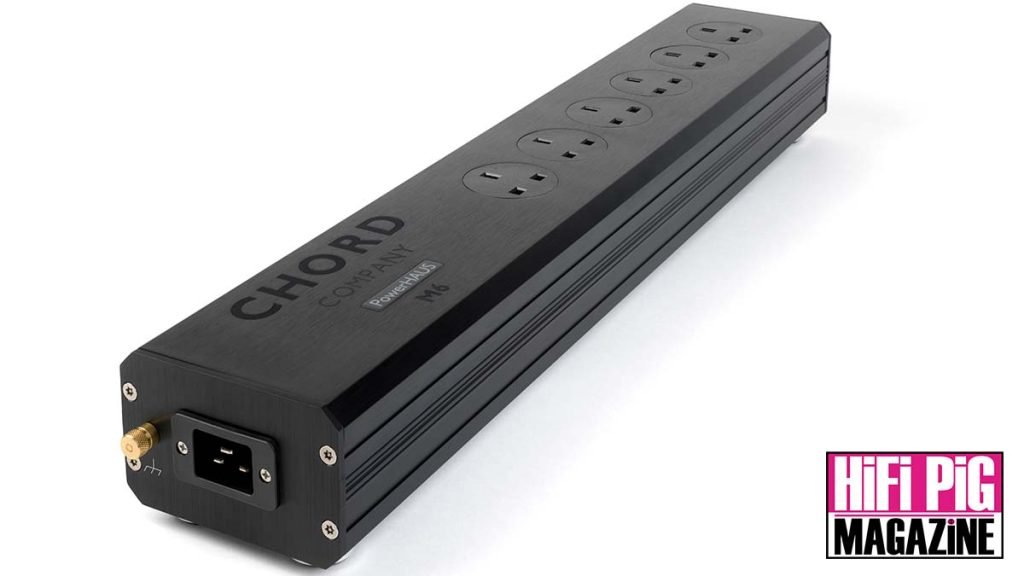THE CHORD COMPANY POWERHAUS M6 MAINS DISTRIBUTION BLOCK REVIEW
Chris Baillie takes a listen to The Chord Company PowerHAUS M6 Mains Distribution Block
The Chord Company is one of the UK’s best-known manufacturers of quality audio cables. They have been making and selling power cables for many years, so it is perhaps surprising that it has taken them so long to produce their own high-quality mains distribution block. Launched early last year, The Chord Company’s PowerHAUS S6 (Studio) and M6 (Master), six-way mains distribution blocks result from many years of development by their engineers. Despite this, they only recently felt they had something ready to market and sought CE approval for the products. The blocks appear to have proved popular with Chord Co’s dealer network and the public at last year’s audio shows.
So why would users connect their systems to a distribution block such as the PowerHAUS, fed from a single mains socket, rather than directly connecting multiple wall sockets? It is said that connecting this way earths the whole system to the same point, which some say can be sonically beneficial.
Priced at £2,000, the M6 is a premium product designed for users of higher-end audio systems. Also available is the PowerHAUS S6, which at first glance looks similar to the M6, although a little shorter. The main difference between the two blocks is that the S6 lacks the M6’s three MainsARAY elements connected in parallel, instead making do with a SuperARAY system connected at mains level.The S6 is priced at £1,000.
Both models connect from the wall into a 16A socket, the cable for which buyers must purchase separately. For this review, The Chord Company supplied one of their ARAY power cables, which retails for a further £750 for the 1.5m length provided, or £500 for 1m. Effectively, I am reviewing a £2,750 combo. My sample came with six high-quality UK spec unswitched IEC sockets. Euro, otherwise known as Schuko unswitched output sockets, are also available.

USers will need to buy their own cable with 16Amp connector
BUILD QUALITY AND DESIGN
The PowerHAUS M6 is extremely attractive and well-finished. Aluminium is used to reduce both microphony and RFI. It could be considered imposing to some eyes, being taller and longer than more basic blocks. As I eluded to earlier, the block extends beyond the sockets by several centimetres to house Hybrid Mains ARAYs. I am sure readers will wonder what a Mains ARAY is, as I did. The Chord Co uses the term ARAY technology in describing various cables and products throughout its product range. The Chord Company’s marketing department told me that the acronym relates to a range of tuning technologies based around the mechanical grounding of signal cables. I am not sure that I am any the wiser, having been given this info, but that is all I have folks. The PowerHAUS range forgoes ‘star wiring’, which is popular in rival products, as Chord’s research found it can make such a device susceptible to RFI.
The sockets are connected in parallel, rather than in series, direct to three isolated bus bars. This is said to reduce high-frequency noise. Following listening trials by The Chord Co, they say that superior results were obtained by connecting the earth to a separate bus bar. There are no LED lights or switches, again for sonic reasons. The sockets used in the PowerHAUS range are said to have been chosen for performance and reliability considerations. The Chord Co’s designers went to great lengths to reduce vibrations as far as possible, as their engineers found that microphony in the mains signal degrades the sound quality. Many enthusiasts and designers believe mains filters impact dynamics and ‘musicality’. I have enjoyed listening to systems with and without mains filters, but The Chord Company feel the without sounds best, so you will not find them in their mains blocks. The acronym HAUS in PowerHAUS stands for ‘Hybrid ARAY Unfiltered Supply’. Thick gauge cable is used throughout the product. There is a terminal next to the 16amp mains input socket so that users can connect the block to a separate earth point. Unfortunately, I was unable to test this feature.

The Chord Company PowerHAUS is available in EU version too
DOES THE POWERHAUS M6 MAKE MUSIC SOUND BETTER?
I installed the M6 in my main system for a few weeks, consisting of a Moon Audio 600i amp and 780D streaming DAC fed by a Melco digital server. My speakers are Totem Forest Signatures. Digital cables are from Network Acoustics, and analogue cables are from Townsend Audio. Power is usually supplied to my system via a ‘Hydra’, comprising a single mains plug, feeding a box where four shielded mains cables exit. The advantage of this arrangement is that just a single fuse is used, as each of the four cables that connect to the components that form my system, directly exits the Hydra block. The Hydra is great from a performance perspective but is not the ideal reviewing tool.
For this reason, a few days before the PowerHAUS arrived, I substituted the Hydra for the Russ Andrews PowerBar S and Yello Cables, which I reviewed for HiFi Pig some time ago. Following acclimatisation to the change in sonic balance, this arrangement allowed me to swap out the RA block and replace it with the PowerHAUS M6, keeping the RA Yello cables in situ. The unavoidable inconsistency here is that the PowerBar S has a 13amp input rather than the M6’s 16amp, so a RA PowerKord Evolution 100 fed the RA block, and The Chord Co’s Epic ARAY fed the M6. The PowerBar S is an excellent product and represents fine value at £154. RA’s top-of-the-range PowerBlock would have been a fairer comparison, but I did not have one at my disposal.
So what did the PowerHAUS M6 bring to the party? A seemingly dramatic lowering of the noise floor. Immediately the music was less tied to the speaker cabinets and seemed to ‘float’ between them and around them. I noted a slight improvement in stereo depth, but more significant was the precision of instrument placement, both between and in front of the speakers. The effect was more apparent when listening to recordings that projected the soundstage beyond the width of the speakers, such as Roger Waters’ Amused To Death. I found the usual ‘sweet spot’ I formerly needed to sit in to enjoy a holographic soundstage was now wider. Dynamics were immediately more pronounced, as was particularly highlighted whilst listening to a 24/96 FLAC of Steven Wilson’s Hand Can Not Erase album. The guitar solos on the tracks Home Invasion/Regret #9 and Ancestral cut through the dense mix dramatically, to startling effect. The timing qualities of the percussion instruments were easier to appreciate than I had noted from previous listenings to this album.
Generally, the music sounded cleaner and more defined. One may describe the sound as brighter in balance, but that term is often misused and interpreted as something negative. In other words, with the PowerHAUS in situ, instruments and singers at all frequencies are better defined and easier to follow, almost as if a spotlight was shining on them. The bass is cleaner, more detailed, and subjectively appears fuller and deeper. Cymbals are reproduced in a cleaner, crisper, and more airy fashion. I found it was possible to enjoy music at a lower volume since installing the PowerHAUS M6. As I type, I am listening to a CD rip of David Sylvian’s Dead Bees On A Cake at the sort of volume level one could easily hold a conversation over, and the music sounds full, detailed, dynamic, and spacious. Surprisingly even the low frequencies are still reproduced with authority at this low volume. I found one caveat with the improved detail and definition; those recordings with an overly ‘bright’ edge sounded a little more unpleasant than via my usual mains arrangement. However, I feel that the cleaner electrical signal PowerHAUS M6 supplies to my set-up simply means my system tells me more about the recordings in my collection. Indeed, finely engineered music was reproduced with a clean and silky top end.

A grounding point is provided for those that want to experiment with this
CONCLUSION
You can probably tell that I am pleased with the improvements the Chord PowerHAUS M6 has brought to my system. Via the M6, I believe that what I am hearing is my system performing closer to its potential. I feel the improvements it has made are extremely worthwhile in a system which is already at a level that I would say is close to the ‘end-game’ level. Potential buyers will have to decide if the £2,750 entry fee for the M6 and Epic ARAY cable to feed it are the best way to spend their money. For those with lesser systems, I can say that I have previously spent some time with the PowerHAUS S6, which retails for half the price of the M6, and it has similar qualities, but they do not extend to the same heights. I could live with either, but assuming funds are available, I would dig deep to find the extra money for the M6.
AT A GLANCE
Build Quality:
For sonic reasons, the block is exceptionally rigid
The finish is excellent, and it looks the business
Sound Quality:
It allowed my system to perform closer to what I believe is its full potential
I heard cleaner-sounding music that seemed to float around the speakers
Frequency extension was subjectively wider, timing qualities of musicians were easier to appreciate
Via the PowerHAUS M6, the music sounds more dynamic and has a greater impact
The soundstage was more open and easier to hear what was going on within it
Value For Money:
£2,000 plus the additional cost of a high-quality 16amp cable with which to feed it is a lot of money. However, in the context of what it does for my system, I feel it is worth it. The Chord Company’s PowerHAUS S6 is a more affordable option for lower-priced but still high-performance systems.
We Loved:
It looks and feels great and has taken the performance of my system to another level.
We Didn’t Love So Much:
Not everyone can afford the price of entry. A consequence of the increased resolution the M6 enables your system to produce could make it too revealing of poor recordings or even highlight problems elsewhere in your setup.
Elevator Pitch Review: If your system is already at a level you are happy with, the PowerHAUS M6 from The Chord Company has to potential to make it sound even better. Who knows, it might stop you from spending even more money on a significant component upgrade.
Price:
PowerHAUS M6, six-way mains distribution block – £2,000
Chord Company Epic ARAY mains cable – £750 for 1.5m as supplied, £500 for 1m.

CHRIS BAILLIE



















































































































































































